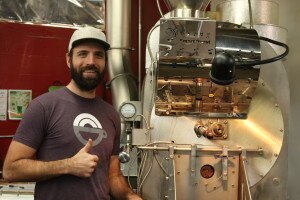Exhaust Air Temperature
Written for Ikawa Coffee: See the full post here
"As coffee roasters, I feel it is safe to say that we spend the majority of our time thinking about the bean temperature thermocouple. It is a major focus because thinking about what is happening to our coffee is the most important thing. Built into that however, is the somewhat erroneous concept that the bean temperature thermocouple is an accurate measurement or representation of what is actually happening with the bean mass.
Depending on batch size, thermocouple placement, thickness, and type, we could be seeing a wide range of variation in readout of the bean temp thermocouple. Because of this, focusing exclusively on the bean thermocouple temperature as if holy writ, keeps us from observing what is happening holistically in the roaster.I'm not saying that we shouldn't use bean temperature as a means for roast profile control and consistency. What we need to do, rather, is look at the larger picture of heat transfer that is at work inside the roaster (that - and get thinner more responsive thermocouples - and make sure they are located where they will always be covered by the bean mass in the roaster ;-) ).So this leads us to the next question: “What is another piece of data feedback we are provided with during roasting which can help us interpret what is happening in the roaster?”The answer is actually the OG* when it comes to thermocouples, pre-dating bean temperature in most manufacturers, and that is the exhaust temperature. Though it goes by many names (exhaust temperature, return-air-temperature, environmental temperature, etc) it represents a measurement taken of the heat energy in the flow of air exiting the roasting chamber.This data is the result of a number of different variables; inlet air temperature/heat application, heat absorption by roasting system, and heat absorption by bean mass. It is, essentially, the remainder of the heat energy input into the roasting mass, and it helps us understand a bit more about what’s going on with regards to heat transfer in the roasting system.So how can we use exhaust air temperature as a means to understand what is happening to the beans? Let’s understand its implications based on the differences (or Δ) between inlet air, bean temperature, and exhaust air. At the beginning of the roasting process, the beans are coming in at room temperature. This means that the beans are at their lowest part of the roast curve or profile. On many roasters (most I would presume) this is not shown, as the chamber is pre-heated beforehand and we show the lowest point as being where the falling temperature of the bean probe thermocouple and the rising temperature of the bean mass meet one another and begin to rise together (Turn Around Point, Equilibrium, etc). We likewise have a dip in exhaust air temperature after the green coffee is added to the roaster because much of the heat energy is being absorbed by the green coffee. In order for the roaster to bring the exhaust air temperature up once more, it requires the application of heat and the increase of the inlet air temperature in order to compensate for that absorption. Therefore, at the beginning of the roast, the Δ between all three indicators is at its largest. See pictured below from my Loring 35kilo roaster:



- 400 F around 3:00.
- then try to be at 420F by 6:00
- and to 425F by 8 minutes.
- Afterwards I hover at 425F until I reach the desired development time and end colour for the sample.
Typically speaking this makes my roast come out as follows:
- Pale at 3:00
- Yellow at 4:00
- Brown at 5:00
- First at 8:00
- Out at 10:00 based on bean colour, expansion, and development time.
This general concept can be cross applied to various roasters and forms of roasting to try and control the roast curve of the coffee. (stick with us - IKAWA roast profile coming up shortly!!)This chart shows approximately how the actual bean temperature (red) would change, based on the measured exhaust temperature (blue) based on the above theory.



- La Armonia Hermosa
- Guatemala - Near Antigua
- 1500-2000 masl
- Washed - Patio Dried
- Bourbon, Caturra, Catuai, Pache, and Paca Cultivars
This profile essentially allowed me to experience a similar roast profile (with regards to colour changes and events) that I would experience sample roasting on my 3 kilo, or a BRZ or the like.
- I hit yellowing around 4
- brown around 5
- first crack close to 7
- and had a development time of close to 2 minutes.
While I am still tweaking and playing around with this profile, I’ve found the profile to closely mimic a traditional sample roast of a coffee.All of that to say this simple mantra... When it comes to thinking about how to profile using the exhaust air on the IKAWA, or any roaster for that matter (even if the bean temperature is unknown and you are estimating based on colour), remember:
- the greater the difference between the bean temperature and the exhaust air => the greater the rate of rise of bean temperature
conversely
- the lesser the difference temperature difference => the lower the rate of rise.
If you are trying to finesse something into your sample roasting protocol, I hope you find this helps you to get into the right ballpark more quickly. And if you are just looking to explore or have an adventure with a particular coffee I hope this helps you understand the changes you can cause in the coffee.”

